From Interference to Fluency: Analysing Indonesian Students' Progress in English Oral Communication
Abstract
This study examines the progress of Indonesian students in spoken English through a task-based approach in an EFL classroom. The aim of the study is to identify communication strategies and linguistic aspects used by the students during oral interaction and production. The data collected from 50 Indonesian students attending a Phonetics and Phonology course at Universitas Bandar Lampung was analyzed using triangulation with class diary and self-assessment questionnaires. The findings show significant improvements in oral interaction and production, including negotiation, cooperation, mediation, intonation, fluency, pronunciation, and rhythm. However, the students made less effort to intervene in the spoken code of the interlocutor and their own interlanguage. The study recommends training tasks that emphasize paraphrasing and self-improvement of oral discourse to enhance their overall oral proficiency in English. The findings of this study have important implications and provides a promising framework for improving students' communication strategies and linguistic aspects. Therefore, these findings suggest that effective language teaching should prioritize not only linguistic aspects but also communication strategies that enable effective oral interaction. This study's recommendations could be useful for language educators worldwide seeking to enhance their students' overall oral proficiency in English.
Downloads
References
Abrar, M., Mukminin, A., Habibi, A., Asyrafi, F., & Marzulina, L. (2018). “If our English isn’t a language, what is it?” Indonesian EFL student teachers’ challenges speaking English. The Qualitative Report, 23(1), 129–145. Retrieved from https://nsuworks.nova.edu/tqr/vol23/iss1/9/
Afshar, H. S. (2021). Task-related focus-on-forms foreign language vocabulary development: Focus on spoken form and word parts. System, 96, 102406. https://doi.org/10.1016/J.SYSTEM.2020.102406
Arifin, W. L. (2017). Psychological problems and challenge in EFL speaking classroom. Register Journal, 10(1), 29–47. https://doi.org/10.18326/rgt.v10i1.29-47
Bautista-Vallejo, J. M., Hernández-Carrera, R. M., Moreno-Rodriguez, R., & Lopez-Bastias, J. L. (2020). Improvement of memory and motivation in language learning in primary education through the Interactive Digital Whiteboard (IDW): The future in a post-pandemic period. Sustainability, 12(19), 8109. https://doi.org/10.3390/SU12198109
Beghetto, R. A. (2006). Creative self-efficacy: Correlates in middle and secondary students. Creativity Research Journal, 18(4), 447–457. https://doi.org/10.1207/S15326934CRJ1804_4
Begum, R. (2011). Prospect for cell phones as instructional tools in the EFL classroom: A case study of Jahangirnagar University, Bangladesh. English Language Teaching, 4(1), 105–115. Retrieved from https://eric.ed.gov/?id=EJ1080334
Beltrán-Planques, V., & Querol-Julián, M. (2018). English language learners’ spoken interaction: What a multimodal perspective reveals about pragmatic competence. System, 77, 80–90. https://doi.org/10.1016/J.SYSTEM.2018.01.008
Boersma, P., & Weenink, D. (2021). Praat: Doing phonetics by computer. Retrieved from https://www.praat.org
Brown, J. D., & Rodgers, T. S. (2002). Doing Second Language Research. Oxford: Oxford University Press.
Chang, C. B. (2019). Language change and linguistic inquiry in a world of multicompetence: Sustained phonetic drift and its implications for behavioral linguistic research. Journal of Phonetics, 74, 96–113. https://doi.org/10.1016/J.WOCN.2019.03.001
Chauvin, R., Fenouillet, F., & Scott Brewer, S. (2020). An investigation of the structure and role of English as a Foreign Language self-efficacy beliefs in the workplace. System, 91, 102251. https://doi.org/10.1016/J.SYSTEM.2020.102251
Chen, J. C., & Kent, S. (2020). Task engagement, learner motivation and avatar identities of struggling English language learners in the 3D virtual world. System, 88, 102168. https://doi.org/10.1016/J.SYSTEM.2019.102168
Chien, S. Y., Hwang, G. J., & Jong, M. S. Y. (2020). Effects of peer assessment within the context of spherical video-based virtual reality on EFL students’ English-speaking performance and learning perceptions. Computers & Education, 146, 103751. https://doi.org/10.1016/J.COMPEDU.2019.103751
Cloudia Ho, Y. Y. (2020). Communicative language teaching and English as a foreign language undergraduates’ communicative competence in Tourism English. Journal of Hospitality, Leisure, Sport & Tourism Education, 27, 100271. https://doi.org/10.1016/J.JHLSTE.2020.100271
Cui, G., & Wang, S. (2008). Adopting cell phones in EFL teaching and learning. Journal of Educational Technology Development and Exchange (JETDE), 1(1), 69–80. https://doi.org/10.18785/jetde.0101.06
Dias, J. W., Vazquez, T. C., & Rosenblum, L. D. (2021). Perceptual learning of phonetic convergence. Speech Communication, 133, 1–8. https://doi.org/10.1016/J.SPECOM.2021.07.004
Dikilitas, K., & Reynolds, K. M. (Eds.). (2022). Research Methods in Language Teaching and Learning: A practical guide. New York: John Wiley & Sons Inc.
Flege, J. E., Bohn, O. S., & Jang, S. (1997). Effects of experience on non-native speakers’ production and perception of English vowels. Journal of Phonetics, 25(4), 437–470. https://doi.org/10.1006/JPHO.1997.0052
Gall, M. D., Gall, J. P., & Borg, W. R. (2014). Applying Educational Research: How to read, do, and use research to solve problems of practice (6th ed.). Essex: Pearson Education Limited.
Grant, L. E. (2011). The frequency and functions of just in British academic spoken English. Journal of English for Academic Purposes, 10(3), 183–197. https://doi.org/10.1016/J.JEAP.2011.05.006
Halliday, M. A. K. (Michael A. K., & Greaves, W. S. (2008). Intonation in the Grammar of English. London: Equinox Pub.
Hamid, F., Rinawati, D., Mahrudin, M. A. F. S., Husna, N., Hidayat, D. N., & Mursyid, A. M. M. (2022). Teaching strategies in EFL hybrid classroom: A case study in a Junior High School. IDEAS: Journal on English Language Teaching and Learning, Linguistics and Literature, 10(1), 135–151. https://doi.org/10.24256/IDEAS.V10I1.2522
Haselow, A. (2012). Subjectivity, intersubjectivity and the negotiation of common ground in spoken discourse: Final particles in English. Language & Communication, 32(3), 182–204. https://doi.org/10.1016/J.LANGCOM.2012.04.008
Haselow, A. (2021). The acquisition of pragmatic markers in the foreign language classroom: An experimental study on the effects of implicit and explicit learning. Journal of Pragmatics, 186, 73–86. https://doi.org/10.1016/J.PRAGMA.2021.09.017
Herazo, J. D. (2021). Mediating spoken meaning-making in genre-based lessons: The role of metalinguistic concepts. System, 96, 102398. https://doi.org/10.1016/J.SYSTEM.2020.102398
Huang, L. J. D. (2021). Developing intercultural communicative competence in foreign language classrooms: A study of EFL learners in Taiwan. International Journal of Intercultural Relations, 83, 55–66. https://doi.org/10.1016/J.IJINTREL.2021.04.015
Hwang, W. Y., & Chen, H. S. L. (2013). Users’ familiar situational contexts facilitate the practice of EFL in elementary schools with mobile devices. Computer Assisted Language Learning, 26(2), 101–125. https://doi.org/10.1080/09588221.2011.639783
Hwang, W. Y., Huang, Y. M., Shadiev, R., Wu, S. Y., & Chen, S. L. (2014). Effects of using mobile devices on English listening diversity and speaking for EFL elementary students. Australasian Journal of Educational Technology, 30(5), 503–516. https://doi.org/10.14742/AJET.237
Ito, Y. (2019). Japanese EFL learners’ perceptions of different accents in spoken English. Australian Journal of Applied Linguistics, 2(2), 61–83. Retrieved from https://eric.ed.gov/?id=EJ1244439
Jamshidnejad, A. (2011). Functional approach to communication strategies: An analysis of language learners’ performance in interactional discourse. Journal of Pragmatics, 43(15), 3757–3769. https://doi.org/10.1016/J.PRAGMA.2011.09.017
Kim, H., & Kwon, Y. (2012). Exploring smartphone applications for effective mobile-assisted language learning. Multimedia-Assisted Language Learning, 15(1), 31–57. Retrieved from https://www.researchgate.net/publication/331831915
Kissling, E. M. (2014). Phonetics instruction improves learners’ perception of L2 sounds. Language Teaching Research, 19(3), 254–275. https://doi.org/10.1177/1362168814541735
Liu, S., & Kinginger, C. (2021). The sociocultural ontogenesis of international students’ use of pragmatic strategies in ELF academic communication: Two contrasting case studies. Journal of Pragmatics, 186, 364–381. https://doi.org/10.1016/J.PRAGMA.2021.10.022
Maldonado, M. R. (2016). Communication strategies used by different level L2 English learners in oral interaction. Revista Signos, 49(90), 71–93. https://doi.org/10.4067/S0718-09342016000100004
Manurung, K. (2015). Improving the speaking skill using reading contextual internet-based instructional materials in an EFL class in Indonesia. Procedia - Social and Behavioral Sciences, 176, 44–51. https://doi.org/10.1016/J.SBSPRO.2015.01.442
Meihami, H. (2022). An exploratory investigation into EFL teacher educators’ approaches to develop EFL teachers’ ability to teach for creativity. Thinking Skills and Creativity, 43, 101006. https://doi.org/10.1016/J.TSC.2022.101006
Moser, M., Zimmermann, M., Pauli, C., Reusser, K., & Wischgoll, A. (2022). Student’s vocal participation trajectories in whole-class discussions during teacher professional development. Learning, Culture and Social Interaction, 34, 100633. https://doi.org/10.1016/J.LCSI.2022.100633
Nakatani, Y. (2005). The Effects of awareness-raising training on oral communication strategy use. The Modern Language Journal, 89(1), 76–91. https://doi.org/10.1111/J.0026-7902.2005.00266.X
Nanda, D. S., & Susanto, S. (2021). Using drama in EFL classroom for exploring students’ knowledge and learning. English Review: Journal of English Education, 9(2), 285–292. Retrieved from https://journal.uniku.ac.id/index.php/ERJEE/article/view/4353/2563
Nuninsari, D. F., Sutopo, D., & Bharati, D. A. L. (2020). The implementation of project based learning strategy in teaching spoken English. English Education Journal, 10(1), 94–101. https://doi.org/10.15294/EEJ.V10I1.33952
Olmstead, A. J., Viswanathan, N., Cowan, T., & Yang, K. (2021). Phonetic adaptation in interlocutors with mismatched language backgrounds: A case for a phonetic synergy account. Journal of Phonetics, 87, 101054. https://doi.org/10.1016/J.WOCN.2021.101054
Ou, W. A., & Gu, M. M. (2020). Negotiating language use and norms in intercultural communication: Multilingual university students’ scaling practices in translocal space. Linguistics and Education, 57, 100818. https://doi.org/10.1016/J.LINGED.2020.100818
Philipsen, G., & Coutu, L. (2005). The ethnography of speaking. In R. Sanders & K. Fitch (Eds.), Handbook of Language and Social Interaction Research (pp. 355–379). Mahwah, NJ: Lawrence Erlabum.
Rojas, M. A., & Villafuerte, J. (2018). The influence of implementing role-play as an educational technique on EFL speaking development. Theory and Practice in Language Studies, 8(7), 726–732. https://doi.org/10.17507/tpls.0807.02
Shi, Y., & Lei, L. (2021). Lexical use and social class: A study on lexical richness, word length, and word class in spoken English. Lingua, 262, 103155. https://doi.org/10.1016/J.LINGUA.2021.103155
Singh, J., Steele, K., & Singh, L. (2021). Combining the best of online and face-to-face learning: Hybrid and blended Learning approach for COVID-19, Post vaccine, & post-pandemic world. Journal of Educational Technology Systems, 50(2), 140–171. https://doi.org/10.1177/00472395211047865
Sun, M., Wang, M., Wegerif, R., & Peng, J. (2022). How do students generate ideas together in scientific creativity tasks through computer-based mind mapping? Computers & Education, 176, 104359. https://doi.org/10.1016/J.COMPEDU.2021.104359
Susanto, S. (2016). A case study of prosodic phrasal grouping and intonational prominence in language acquisition. English Review: Journal of English Education, 4(2), 289–295. Retrieved from https://journal.uniku.ac.id/index.php/ERJEE/article/view/342/263
Tang, T., Vezzani, V., & Eriksson, V. (2020). Developing critical thinking, collective creativity skills and problem solving through playful design jams. Thinking Skills and Creativity, 37, 100696. https://doi.org/10.1016/J.TSC.2020.100696
Tokunaga, M. (2021). Investigating fluency and accuracy of Japanese university EFL learners’ spoken English production. JET (Journal of English Teaching), 7(2), 163–178. https://doi.org/10.33541/JET.V7I2.2775
Vonkova, H., Jones, J., Moore, A., Altinkalp, I., & Selcuk, H. (2021). A review of recent research in EFL motivation: Research trends, emerging methodologies, and diversity of researched populations. System, 103, 102622. https://doi.org/10.1016/J.SYSTEM.2021.102622
Walker, E. (2012). An exploration of planning for English-as-foreign-language (EFL) academic language development. Journal of English for Academic Purposes, 11(4), 304–318. https://doi.org/10.1016/J.JEAP.2012.06.001
Wang, H. C. (2019). The influence of creative task engagement on English L2 learners’ negotiation of meaning in oral communication tasks. System, 80, 83–94. https://doi.org/10.1016/J.SYSTEM.2018.10.015
Willis, D., & Willis, J. (2007). Doing Task-Based Teaching. Oxford: Oxford University Press.
Yang, X., & Yin, S. (2022). Interpersonal projection as EFL teachers’ discourse strategy to enhance students’ willingness to communicate: A systemic-functional perspective. System, 104, 102687. https://doi.org/10.1016/J.SYSTEM.2021.102687
Yenkimaleki, M., & van Heuven, V. J. (2021). Effects of attention to segmental vs. suprasegmental features on the speech intelligibility and comprehensibility of the EFL learners targeting the perception or production-focused practice. System, 100, 102557. https://doi.org/10.1016/J.SYSTEM.2021.102557
Yip, M. C. W. (2020). Spoken word recognition of L2 using probabilistic phonotactics in L1: Evidence from Cantonese-English bilinguals. Language Sciences, 80, 101287. https://doi.org/10.1016/J.LANGSCI.2020.101287
Zhang, S., Gao, Q., Sun, M., Cai, Z., Li, H., Tang, Y., & Liu, Q. (2022). Understanding student teachers’ collaborative problem solving: Insights from an epistemic network analysis (ENA). Computers & Education, 183, 104485.
- Author retains the copyright and grants Elsya Journal the right of first publication of the work simultaneously licensed under the Creative Commons Attribution-ShareAlike 4.0 License that allows others to share the work with an acknowledgment of the work's authorship and initial publication in this journal
- The author is able to enter into separate, additional contractual arrangements for the non-exclusive distribution of the journal's published version of the work (e.g., post it to an institutional repository or publish it in a book) with the acknowledgment of its initial publication in this journal.
- The author is permitted and encouraged to post his/her work online (e.g., in institutional repositories or on their website) prior to and during the submission process, as it can lead to productive exchanges, as well as earlier and greater citation of the published work (See The Effect of Open Access).









 Elsya Journal is licensed under
Elsya Journal is licensed under 